Assessment of Alkali–Silica Reaction Potential in Aggregates from Iran and Australia Using Thin-Section Petrography and Expansion Testing
Abstract
:1. Introduction
2. Materials and Methods
2.1. Sample Materials
2.2. Physical Properties
2.3. Expansion Testing through C1260-07 (AMBT)
2.4. Expansion Testing through C1293-08 (CPT)
2.5. Thin-Section Preparation and Optical Petrography
2.6. Scanning Electron Microscopy (SEM)
2.7. Mineral Content through XRPD Analysis
3. Results
3.1. Optical Thin-Section Petrography
3.1.1. Granite
3.1.2. Rhyodacite
3.1.3. Bathurst Limestone
3.1.4. Ilam Limestone
3.1.5. Dolomite
3.2. Physical and Mechanical Properties of Aggregates
3.3. Mortar Bar Expansion
3.4. Post-Mortem Mortar Bar Microstructure through SEM
3.5. Paste Development through XRPD
3.6. Concrete Prism Expansion
3.7. Post-Mortem Concrete Prism Microstructure
3.8. Optical Petrography of Concrete Prisms
4. Discussion
5. Conclusions
- The petrographic examinations and mechanical properties revealed that among the three studied carbonate aggregates, Bathurst limestone had the highest amount of silica content, effective porosity, and water absorption. According to these findings, it was concluded that Bathurst limestone is more susceptible to ASR.
- Based on the petrographic examinations, rhyodacite contains a microcrystalline-to-glassy matrix, quartz undulatory extinction, and secondary minerals such as sericite, suggesting that rhyodacite aggregate is more likely to be alkali-reactive.
- The reactivity of all the selected aggregates was further verified through AMBT, CPT, SEM/EDS, BSM, and optical microscopy analysis. The results confirmed that among all studied aggregates, the Bathurst limestone and rhyodacite aggregates can be classified as potentially reactive.
- According to the above-mentioned analyses, it was suggested that carbonate aggregates containing higher amounts of reactive silica, effective porosity, and water absorption are more susceptible to ASR. Moreover, the results showed that igneous aggregates with glassy matrix, reactive quartz, undulatory extinction, and secondary minerals, such as sericite and clay minerals, have more potential alkali reactivity. Future long-term studies are needed to identify all changes developing in concretes, as it may take a long time for some cementitious materials to release the alkali. The ASR-susceptibility evaluation of aggregates is recommended for testing the suitability of aggregates for different construction applications in locations with higher humidity levels (e.g., the Persian Gulf or near the Caspian Sea) and elevated temperatures in future work.
Author Contributions
Funding
Institutional Review Board Statement
Informed Consent Statement
Data Availability Statement
Acknowledgments
Conflicts of Interest
References
- Parand, F. Iranian Stone Export to Ukraine: Problems and Barriers. Pet.-Gas Univ. Ploiesti Bull. Econ. Sci. Ser. 2010, 62, 43–56. [Google Scholar]
- Ghorbani, M. The Economic Geology of Iran: Mineral Deposits and Natural Resources; Springer: Berlin/Heidelberg, Germany, 2013; pp. 1–450. [Google Scholar]
- Hobbs, D.W. Alkali-Silica Reaction in Concrete; Thomas Telford Publishing: London, UK, 1988. [Google Scholar]
- Zalooli, A.; Freire-Lista, D.M.; Khamehchiyan, M.; Nikudel, M.R.; Fort, R.; Ghasemi, S. Ghaleh-khargushi rhyodacite and Gorid andesite from Iran: Characterization, uses, and durability. Environ. Earth Sci. 2018, 77, 315. [Google Scholar] [CrossRef]
- Ilkhchi, R.M. Metamorphism and Geotectonic Position of the Shotur Kuh Complex, Central Iranian Block. Ph.D. Thesis, Univerzita Karlova, Přírodovědecká fakulta, Prague, Czech Republic, 2010. [Google Scholar]
- Shin, J.-H.; Struble, L.J.; Kirkpatrick, R.J. Microstructural Changes Due to Alkali-Silica Reaction during Standard Mortar Test. Materials 2015, 8, 8292–8303. [Google Scholar] [CrossRef] [PubMed] [Green Version]
- Stark, D.; Morgan, B.; Okamoto, P. Eliminating or Minimizing Alkali-Silica Reactivity; National Research Council: Washington, DC, USA, 1993. [Google Scholar]
- Langer, W.H. Natural Aggregates of the Conterminous United States; US Government Printing Office: Washington, DC, USA, 1988. [Google Scholar]
- Alexander, M.; Bentur, A.; Mindess, S. Durability of Concrete: Design and Construction; CRC Press: Boca Raton, FL, USA, 2017; Volume 20. [Google Scholar]
- Sims, I.; Poole, A.B. Alkali-Aggregate Reaction in Concrete: A World Review; CRC Press: Boca Raton, FL, USA, 2017. [Google Scholar]
- Hou, X.; Struble, L.J.; Kirkpatrick, R. Formation of ASR gel and the roles of C-S-H and portlandite. Cem. Concr. Res. 2004, 34, 1683–1696. [Google Scholar] [CrossRef]
- Chatterji, S.; Thaulow, N.; Jensen, A. Studies of alkali-silica reaction. part 5. Verification of a newly proposed reaction mechanism. Cem. Concr. Res. 1989, 19, 177–183. [Google Scholar] [CrossRef]
- Poole, A.B.; Sims, I. Concrete Petrography: A Handbook of Investigative Techniques; CRC Press: Boca Raton, FL, USA, 2016. [Google Scholar]
- Alexander, M.G. Alkali–aggregate reaction. In Developments in the Formulation and Reinforcement of Concrete; Woodhead Publishing: Cambridge, UK, 2019; pp. 87–113. [Google Scholar]
- Mindess, S.; Young, F.J.; Darwin, D. Concrete, 2nd ed.; Technical Documents; Prentice Hall: Hoboken, NJ, USA, 2002. [Google Scholar]
- Oberholster, B. Chapter 10: Alkali-silica reaction. In Fulton’s Concrete Technology, 9th ed.; Owens, G., Ed.; Cement & Concrete Institute: Midland, South Africa, 2009; pp. 193–195. [Google Scholar]
- Fanijo, E.O.; Kolawole, J.T.; Almakrab, A. Alkali-silica reaction (ASR) in concrete structures: Mechanisms, effects and evaluation test methods adopted in the United States. Case Stud. Constr. Mater. 2021, 15, e00563. [Google Scholar] [CrossRef]
- Çopuroğlu, O.; Andiç-Çakir, Ö.; Broekmans, M.A.T.M.; Kühnel, R. Mineralogy, geochemistry and expansion testing of an alkali-reactive basalt from western Anatolia, Turkey. Mater. Charact. 2009, 60, 756–766. [Google Scholar] [CrossRef]
- Multon, S.; Sellier, A.; Cyr, M. Chemo–mechanical modeling for prediction of alkali silica reaction (ASR) expansion. Cem. Concr. Res. 2009, 39, 490–500. [Google Scholar] [CrossRef] [Green Version]
- Ponce, J.; Batic, O. Different manifestations of the alkali-silica reaction in concrete according to the reaction kinetics of the reactive aggregate. Cem. Concr. Res. 2006, 36, 1148–1156. [Google Scholar] [CrossRef]
- Khan, N.N.; Saha, A.K.; Sarker, P.K. Evaluation of the ASR of waste glass fine aggregate in alkali activated concrete by concrete prism tests. Constr. Build. Mater. 2020, 266, 121121. [Google Scholar] [CrossRef]
- Nixon, J.P.; Sims, I. RILEM Recommendation of the Prevention of Damage by Alkali-Aggregate Reactions in New Concrete Structures; Springer: Berlin/Heidelberg, Germany, 2016; Volume 17, p. 168. [Google Scholar]
- Lindgård, J.; Andiç-Çakır, Ö.; Fernandes, I.; Rønning, T.F.; Thomas, M.D.A. Alkali–silica reactions (ASR): Literature review on parameters influencing laboratory performance testing. Cem. Concr. Res. 2012, 42, 223–243. [Google Scholar] [CrossRef] [Green Version]
- Katayama, T. The so-called alkali-carbonate reaction (ACR)—Its mineralogical and geochemical details, with special reference to ASR. Cem. Concr. Res. 2010, 40, 643–675. [Google Scholar] [CrossRef]
- Lindgård, J.; Nixon, P.J.; Borchers, I.; Schouenborg, B.; Wigum, B.J.; Haugen, M.; Åkesson, U. The EU “PARTNER” Project—European standard tests to prevent alkali reactions in aggregates: Final results and recommendations. Cem. Concr. Res. 2010, 40, 611–635. [Google Scholar] [CrossRef] [Green Version]
- RILEM. RILEM Recommended Test Method: AAR-1.1—Detection of potential alkali-reactivity—Part 1: Petrographic examination method. In RILEM Recommendations for the Prevention of Damage by Alkali-Aggregate Reactions in New Concrete Structures; RILEM State-of-the-art Report (17); Nixon, P.J., Sims, I., Eds.; Springer: Berlin/Heidelberg, Germany, 2016; pp. 35–60. [Google Scholar]
- Fernandes, I.; dos Anjos Ribeiro, M.; Broekmans, M.A.; Sims, I. RILEM Recommended Test Method: Detection of potential alkali-reactivity—AAR-1.2. In Petrographic Atlas: Characterisation of Aggregates Regarding Potential Reactivity to Alkalis; Springer: Berlin/Heidelberg, Germany, 2016; p. 193. [Google Scholar]
- Dähn, R.; Arakcheeva, A.; Schaub, P.; Pattison, P.; Chapuis, G.; Grolimund, D.; Wieland, E.; Leemann, A. Application of micro X-ray diffraction to investigate the reaction products formed by the alkali–silica reaction in concrete structures. Cem. Concr. Res. 2015, 79, 49–56. [Google Scholar] [CrossRef]
- Cole, W.; Lancucki, C. Products formed in an aged concrete the occurrence of okenite. Cem. Concr. Res. 1983, 13, 611–618. [Google Scholar] [CrossRef]
- Peterson, K.; Gress, D.; Van Dam, T.; Sutter, L. Crystallized alkali-silica gel in concrete from the late 1890s. Cem. Concr. Res. 2006, 36, 1523–1532. [Google Scholar] [CrossRef]
- RILEM. RILEM. RILEM Recommended Test Method: AAR-2—Detection of potential alkali-reactivity—Accelerated mortar-bar test method for aggregates. In RILEM Recommendations for the Prevention of Damage by Alkali-Aggregate Reactions in New Concrete Structures; RILEM State-of-the-art Report (17); Nixon, P.J., Sims, I., Eds.; Springer: Berlin/Heidelberg, Germany, 2016; pp. 61–77. [Google Scholar]
- RILEM. RILEM. RILEM Recommended Test Method: AAR-3—Detection of potential alkali-reactivity—38 °C test method for aggregate combinations using concrete prisms. In RILEM Recommendations for the Prevention of Damage by Alkali-Aggregate Reactions in New Concrete Structures; RILEM State-of-the-art Report (17); Nixon, P.J., Sims, I., Eds.; Springer: Berlin/Heidelberg, Germany, 2016; pp. 79–97. [Google Scholar]
- ASTM C1260-07; Standard Test Method for Potential Alkali Reactivity of Aggregates (Mortar-Bar Method); Annual Book of ASTM Standards (04.02): Concrete and Aggregates. American Society for Testing and Materials: West Conshoshocken, PA, USA, 2007; p. 5.
- ASTM C1293-08b; Test Method for Determination of Length Change of Concrete Due to Alkali-Silica Reaction; Annual Book of ASTM Standards (04.02): Concrete and Aggregates. American Society for Testing and Materials: West Conshoshocken, PA, USA, 2008; p. 7.
- AS 3972—2010; General Purpose and Blended Cements. Standards Australia: Sydney, Australia, 2010.
- ISRM. The Complete ISRM Suggested Methods for Rock Characterization, Testing and Monitoring: 1974–2006; Suggested methods prepared by the commission on testing methods; International Society for Rock Mechanics: Ankara, Turkey, 2007; p. 628. [Google Scholar]
- Terry, R.D.; Chilingar, G.V. Summary of “Concerning some additional aids in studying sedimentary formations,” by MS Shvetsov. J. Sediment. Res. 1955, 25, 229–234. [Google Scholar] [CrossRef]
- Whitney, D.L.; Evans, B.W. Abbreviations for names of rock-forming minerals. Am. Mineral. 2010, 95, 185–187. [Google Scholar] [CrossRef]
- Pouchou, J.-L.; Pichoir, F. Quantitative Analysis of Homogeneous or Stratified Microvolumes Applying the Model “PAP”. In Electron Probe Quantitation; Heinrich, K.F.J., Newbury, D.E., Eds.; Springer: Boston, MA, USA, 1991; pp. 31–75. ISBN 978-1-4899-2617-3. [Google Scholar] [CrossRef]
- Gogte, B. An evaluation of some common Indian rocks with special reference to alkali-aggregate reactions. Eng. Geol. 1973, 7, 135–153. [Google Scholar] [CrossRef]
- Grattan-Bellew, P.E. Microcrystalline quartz, undulatory extinction and the alkali-silica reaction. In Proceedings of the 9th International Conference on Alkali-Aggregate Reaction in Concrete, London, UK, 27–31 July 1992; pp. 383–394. [Google Scholar]
- Locati, F.; Marfil, S.; Baldo, E. Effect of ductile deformation of quartz-bearing rocks on the alkali-silica reaction. Eng. Geol. 2010, 116, 117–128. [Google Scholar] [CrossRef] [Green Version]
- Hallsworth, C.R.; Knox, R. BGS Rock Classification Scheme. Volume 3, Classification of Sediments and Sedimentary Rocks, 2nd ed.; Report (RR 99-03); British Geological Survey: Nottingham, UK, 1999; p. 44. [Google Scholar]
- Moser, R.D.; Jayapalan, A.R.; Garas, V.Y.; Kurtis, K. Assessment of binary and ternary blends of metakaolin and Class C fly ash for alkali-silica reaction mitigation in concrete. Cem. Concr. Res. 2010, 40, 1664–1672. [Google Scholar] [CrossRef]
- Mehta, P.K.; Monteiro, P.J.M. Concrete Microstructure, Properties and Materials; McGraw-Hill Education: New York, NY, USA, 2017. [Google Scholar]
- Steffens, A.; Li, K.; Coussy, O. Aging Approach to Water Effect on Alkali–Silica Reaction Degradation of Structures. J. Eng. Mech. 2003, 129, 50–59. [Google Scholar] [CrossRef]
- Shah, S.P.; Ahmad, S.H. High Performance Concrete. Properties and Applications; McGraw-Hill, Incorporated: New York, NY, USA, 1994. [Google Scholar]
- Bulteel, D.; Garcia-Diaz, E.; Vernet, C.; Zanni, H. Alkali–silica reaction: A method to quantify the reaction degree. Cem. Concr. Res. 2002, 32, 1199–1206. [Google Scholar] [CrossRef]
- Haha, M.B.; Gallucci, E.; Guidoum, A.; Scrivener, K.L. Relation of expansion due to alkali silica reaction to the degree of reaction measured by SEM image analysis. Cem. Concr. Res. 2007, 37, 1206–1214. [Google Scholar] [CrossRef]
- Rocker, P.; Sirivivatnanon, V.; South, W. Linking New Australian Alkali Silica Reactivity Tests to World-Wide Performance Data. In Proceedings of the Biennial National Conference of the Concrete Institute of Australia in conjunction with the 69th RILEM Week, Melbourne, Australia, 30 August–2 September 2015; pp. 502–513. [Google Scholar] [CrossRef]
- Fernandes, I. Role of granitic aggregates in the deterioration of a concrete dam. Bull. Eng. Geol. Environ. 2014, 74, 195–206. [Google Scholar] [CrossRef]
- Fernandes, I. Composition of alkali–silica reaction products at different locations within concrete structures. Mater. Charact. 2009, 60, 655–668. [Google Scholar] [CrossRef]
- Katayama, T. Petrographic Study of the Alkali-Aggregate Reactions in Concrete. Ph.D. Thesis, Department of Earth and Planetary Science, Graduate School of Science, University of Tokyo, Tokyo, Japan, 2012. [Google Scholar]
- Leemann, A.; Lura, P. E-modulus of the alkali–silica-reaction product determined by micro-indentation. Constr. Build. Mater. 2013, 44, 221–227. [Google Scholar] [CrossRef]
- Leemann, A.; Merz, C. An attempt to validate the ultra-accelerated microbar and the concrete performance test with the degree of AAR-induced damage observed in concrete structures. Cem. Concr. Res. 2013, 49, 29–37. [Google Scholar] [CrossRef]
- Thaulow, N.; Jakobsen, U.H.; Clark, B. Composition of alkali silica gel and ettringite in concrete railroad ties: SEM-EDX and X-ray diffraction analyses. Cem. Concr. Res. 1996, 26, 309–318. [Google Scholar] [CrossRef]
- Çopuroğlu, O. Microanalysis of crystalline ASR products from a 50 year-old concrete structure. In Proceedings of the 14th Euroseminar on Microscopy Applied to Building Materials, International Cement Microscopy Association, Helsingør, Denmark, 10–14 June 2013. [Google Scholar]
- Singurindy, O.; Berkowitz, B. Flow, dissolution, and precipitation in dolomite. Water Resour. Res. 2003, 39, 1143. [Google Scholar] [CrossRef] [Green Version]
- Khalaf, F.; Abdal, M. Dedolomitization of dolocrete deposits in Kuwait, Arabian Gulf. Geol. Rundsch. 1993, 82, 741–749. [Google Scholar] [CrossRef]
- Escorcia, L.; Gomez-Rivas, E.; Daniele, L.; Corbella, M. Dedolomitization and reservoir quality: Insights from reactive transport modelling. Geofluids 2013, 13, 221–231. [Google Scholar] [CrossRef]
- Bruckschen, P.; Neuser, R.; Richter, D. Cement stratigraphy in Triassic and Jurassic limestones of the Weserbergland (northwestern Germany). Sediment. Geol. 1992, 81, 195–214. [Google Scholar] [CrossRef]
- Yuan, X.-H.; Chen, W.; Lu, Z.-A.; Chen, H. Shrinkage compensation of alkali-activated slag concrete and microstructural analysis. Constr. Build. Mater. 2014, 66, 422–428. [Google Scholar] [CrossRef]
- Maas, A.; Ideker, J.; Juenger, M.C. Alkali silica reactivity of agglomerated silica fume. Cem. Concr. Res. 2007, 37, 166–174. [Google Scholar] [CrossRef]
- Beyene, M.; Snyder, A.; Lee, R.; Blaszkiewicz, M. Alkali Silica Reaction (ASR) as a root cause of distress in a concrete made from Alkali Carbonate Reaction (ACR) potentially susceptible aggregates. Cem. Concr. Res. 2013, 51, 85–95. [Google Scholar] [CrossRef]
- Hernandez, N.; Lizarazo-Marriaga, J.; Rivas, M.A. Petrographic characterization of Portlandite crystal sizes in cement pastes affected by different hydration environments. Constr. Build. Mater. 2018, 182, 541–549. [Google Scholar] [CrossRef]
- Wild, S.; Khatib, J. Portlandite consumption in metakaolin cement pastes and mortars. Cem. Concr. Res. 1997, 27, 137–146. [Google Scholar] [CrossRef]
- Štukovnik, P.; Bosiljkov, V.B.; Marinšek, M. Detailed investigation of ACR in concrete with silica-free dolomite aggregate. Constr. Build. Mater. 2019, 216, 325–336. [Google Scholar] [CrossRef]
- Min, D.; Mingshu, T. Mechanism of dedolomitization and expansion of dolomitic rocks. Cem. Concr. Res. 1993, 23, 1397–1408. [Google Scholar] [CrossRef]
- Saha, A.K.; Khan, M.; Sarker, P.; Shaikh, F.; Pramanik, A. The ASR mechanism of reactive aggregates in concrete and its mitigation by fly ash: A critical review. Constr. Build. Mater. 2018, 171, 743–758. [Google Scholar] [CrossRef]
- Sarkar, S.L.; Zollinger, D.G.; Mukhopadhyay, A.K.; Lim, S.; Shon, C.S. Handbook for Identification of Alkali-Silica Reactivity in Airfield Pavements; AC No150/5380-8 Append; US Department of Transportation, Federal Aviation Administration: Washington, DC, USA, 2004; p. 1. [Google Scholar]
- Yang, S.; Cui, H.; Poon, C.S. Assessment of in-situ alkali-silica reaction (ASR) development of glass aggregate concrete prepared with dry-mix and conventional wet-mix methods by X-ray computed micro-tomography. Cem. Concr. Compos. 2018, 90, 266–276. [Google Scholar] [CrossRef]
- Hartman, M.; Berliner, R. Investigation of the structure of ettringite by time-of-flight neutron powder diffraction techniques. Cem. Concr. Res. 2006, 36, 364–370. [Google Scholar] [CrossRef]
- Cody, A.M.; Lee, H.; Cody, R.D.; Spry, P.G. The effects of chemical environment on the nucleation, growth, and stability of ettringite [Ca3Al(OH)6]2(SO4)3·26H2O. Cem. Concr. Res. 2004, 34, 869–881. [Google Scholar] [CrossRef]
- Baur, I.; Keller, P.; Mavrocordatos, D.; Wehrli, B.; Johnson, C. Dissolution-precipitation behaviour of ettringite, monosulfate, and calcium silicate hydrate. Cem. Concr. Res. 2004, 34, 341–348. [Google Scholar] [CrossRef]
- Prinčič, T.; Štukovnik, P.; Pejovnik, S.; De Schutter, G.; Bosiljkov, V.B. Observations on dedolomitization of carbonate concrete aggregates, implications for ACR and expansion. Cem. Concr. Res. 2013, 54, 151–160. [Google Scholar] [CrossRef]
- Chen, X.; Yang, B.; Mao, Z.; Deng, M. The Expansion Cracks of Dolomitic Aggregates Cured in TMAH Solution Caused by Alkali–Carbonate Reaction. Materials 2019, 12, 1228. [Google Scholar] [CrossRef] [Green Version]
- Katayama, T. Petrography of alkali-aggregate reactions in concrete-reactive minerals and reaction products. In Proceedings of the Supplementary Papers of East Asia Alkali-Aggregate Reaction Seminar, Tottori, Japan, 23–25 November 1997; pp. 45–59. [Google Scholar]
- Czapik, P. Microstructure and Degradation of Mortar Containing Waste Glass Aggregate as Evaluated by Various Microscopic Techniques. Materials 2020, 13, 2186. [Google Scholar] [CrossRef]
- Lukschová, Š.; Přikryl, R.; Pertold, Z. Petrographic identification of alkali–silica reactive aggregates in concrete from 20th century bridges. Constr. Build. Mater. 2009, 23, 734–741. [Google Scholar] [CrossRef]
- Dollar-Mantuani, L.M.M. Undulatory extinction in quartz used for identifying potentially alkali-reactive rocks. In Proceedings of the Conference on Alkali-Aggregate Reaction in Concrete, Toronto, ON, Canada, 30 March 1981; Volume 30. [Google Scholar]
- Monteiro, P.J.M.; Shomglin, K.; Wenk, H.R.; Hasparyk, N.P. Effect of aggregate deformation on alkali-silica reaction. Mater. J. 2001, 98, 179–183. [Google Scholar]
- Murlidhar, B.R.; Mohamad, E.T.; Armaghani, D.J. Potential alkali silica reactivity of various rock types in an aggregate granite quarry. Measurement 2016, 81, 221–231. [Google Scholar] [CrossRef]
- Bérubé, M.-A.; Frenette, J. Testing Concrete for AAR in NaOH and NaCl solutions at 38 °C and 80 °C. Cem. Concr. Compos. 1994, 16, 189–198. [Google Scholar] [CrossRef]
- Rajabipour, F.; Giannini, E.; Dunant, C.; Ideker, J.; Thomas, M.D. Alkali–silica reaction: Current understanding of the reaction mechanisms and the knowledge gaps. Cem. Concr. Res. 2015, 76, 130–146. [Google Scholar] [CrossRef]
- Van Aardt, J.H.P.; Visser, S. Calcium hydroxide attack on feldspars and clays: Possible relevance to cement-aggregate reactions. Cem. Concr. Res. 1977, 7, 643–648. [Google Scholar] [CrossRef]
- Bérubé, M.-A.; Duchesne, J.; Dorion, J.; Rivest, M. Laboratory assessment of alkali contribution by aggregates to concrete and application to concrete structures affected by alkali–silica reactivity. Cem. Concr. Res. 2002, 32, 1215–1227. [Google Scholar] [CrossRef]
- Constantiner, D.; Diamond, S. Alkali release from feldspars into pore solutions. Cem. Concr. Res. 2003, 33, 549–554. [Google Scholar] [CrossRef]
- Broekmans, M.A. Deleterious Reactions of Aggregate with Alkalis in Concrete. Rev. Miner. Geochem. 2012, 74, 279–364. [Google Scholar] [CrossRef]
- Broekmans, M.A. Structural properties of quartz and their potential role for ASR. Mater. Charact. 2004, 53, 129–140. [Google Scholar] [CrossRef]
- Tiecher, F.; Gomes, M.E.B.; Dal Molin, D.C.; Hasparyk, N.P.; Monteiro, P.J.M. Relationship between Degree of Deformation in Quartz and Silica Dissolution for the Development of Alkali-Silica Reaction in Concrete. Materials 2017, 10, 1022. [Google Scholar] [CrossRef] [Green Version]
- Wenk, H.-R.; Monteiro, P.J.M.; Shomglin, K. Relationship between aggregate microstructure and mortar expansion. A case study of deformed granitic rocks from the Santa Rosa mylonite zone. J. Mater. Sci. 2007, 43, 1278–1285. [Google Scholar] [CrossRef]
- Leemann, A.; Holzer, L. Alkali-aggregate reaction—Identifying reactive silicates in complex aggregates by ESEM observation of dissolution features. Cem. Concr. Compos. 2005, 27, 796–801. [Google Scholar] [CrossRef]
- Katayama, T. How to identify carbonate rock reactions in concrete. Mater. Charact. 2004, 53, 85–104. [Google Scholar] [CrossRef]
- Grattan-Bellew, P.E.; Mitchell, L.D.; Margeson, J.; Min, D. Is alkali–carbonate reaction just a variant of alkali–silica reaction ACR = ASR? Cem. Concr. Res. 2010, 40, 556–562. [Google Scholar] [CrossRef]
- Grattan-Bellew, P.; Chan, G. Comparison of the morphology of alkali–silica gel formed in limestones in concrete affected by the so-called alkali–carbonate reaction (ACR) and alkali–silica reaction (ASR). Cem. Concr. Res. 2013, 47, 51–54. [Google Scholar] [CrossRef]
- Swenson, E.G. A reactive aggregate undetected by ASTM tests. ASTM Bull. 1957, 226, 48–51. [Google Scholar]
- Swenson, E.G.; Gillott, J.E. Characteristics of Kingston carbonate rock reaction. Highw. Res. Board Bull. 1960, 275, 18–31. [Google Scholar]
- Swenson, E.G.; Gillott, J.E. Alkali-carbonate rock reaction. Highw. Res. Rec. 1964, 45, 21–40. [Google Scholar]
- Czapik, P. Degradation of Glaukonite Sandstone as a Result of Alkali-Silica Reactions in Cement Mortar. Materials 2018, 11, 924. [Google Scholar] [CrossRef] [Green Version]
- Grattan-Bellew, P.E.; Rogers, C.A. Expansion due to alkali-carbonate reaction: Laboratory prognosis versus field experience. In Proceedings of the 11th ICAAR, Quebec City, QC, Canada, 11–16 June 2000. [Google Scholar]
- Islam, M.S.; Akhtar, S. A critical assessment to the performance of alkali–silica reaction (ASR) in concrete. Can. Chem. Trans. 2013, 1, 253–266. [Google Scholar]
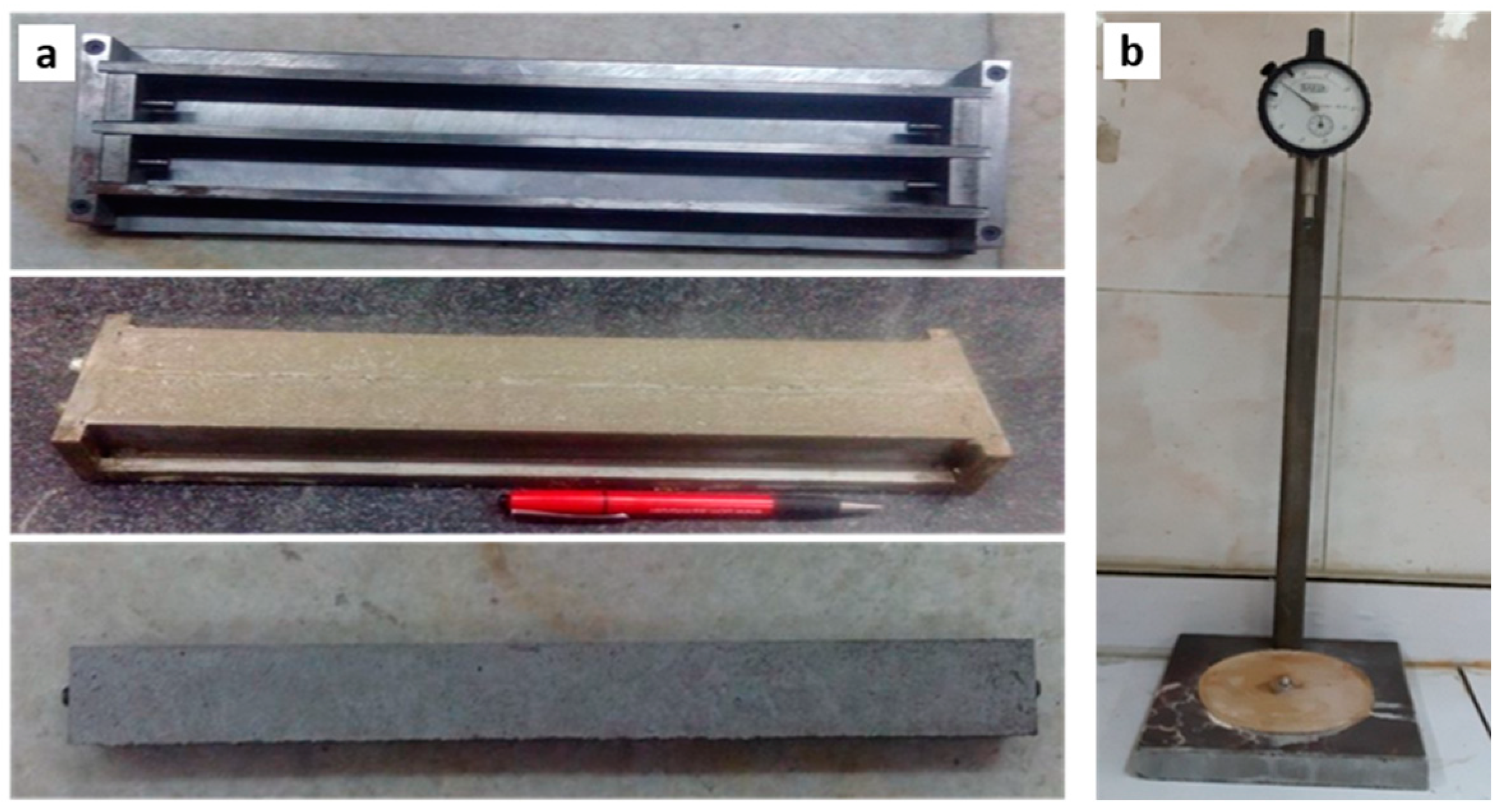
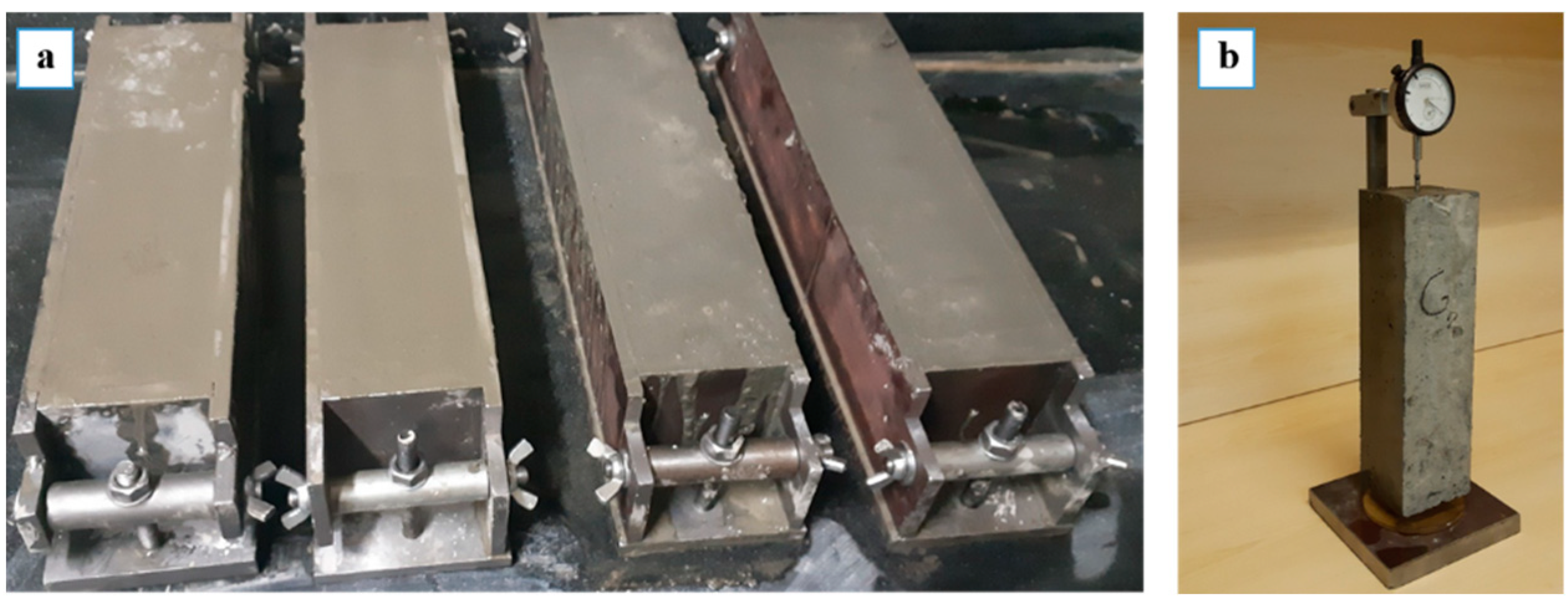
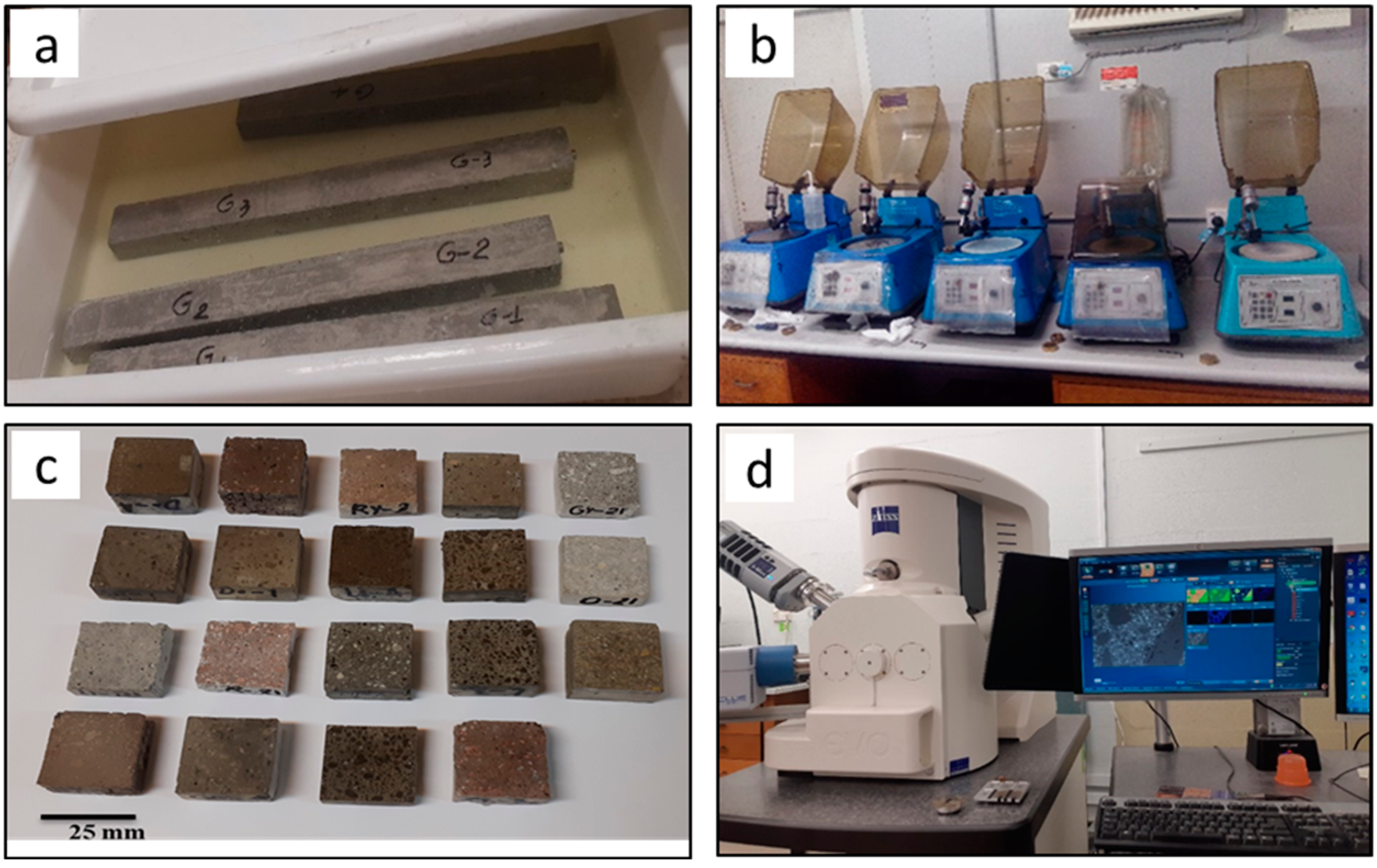

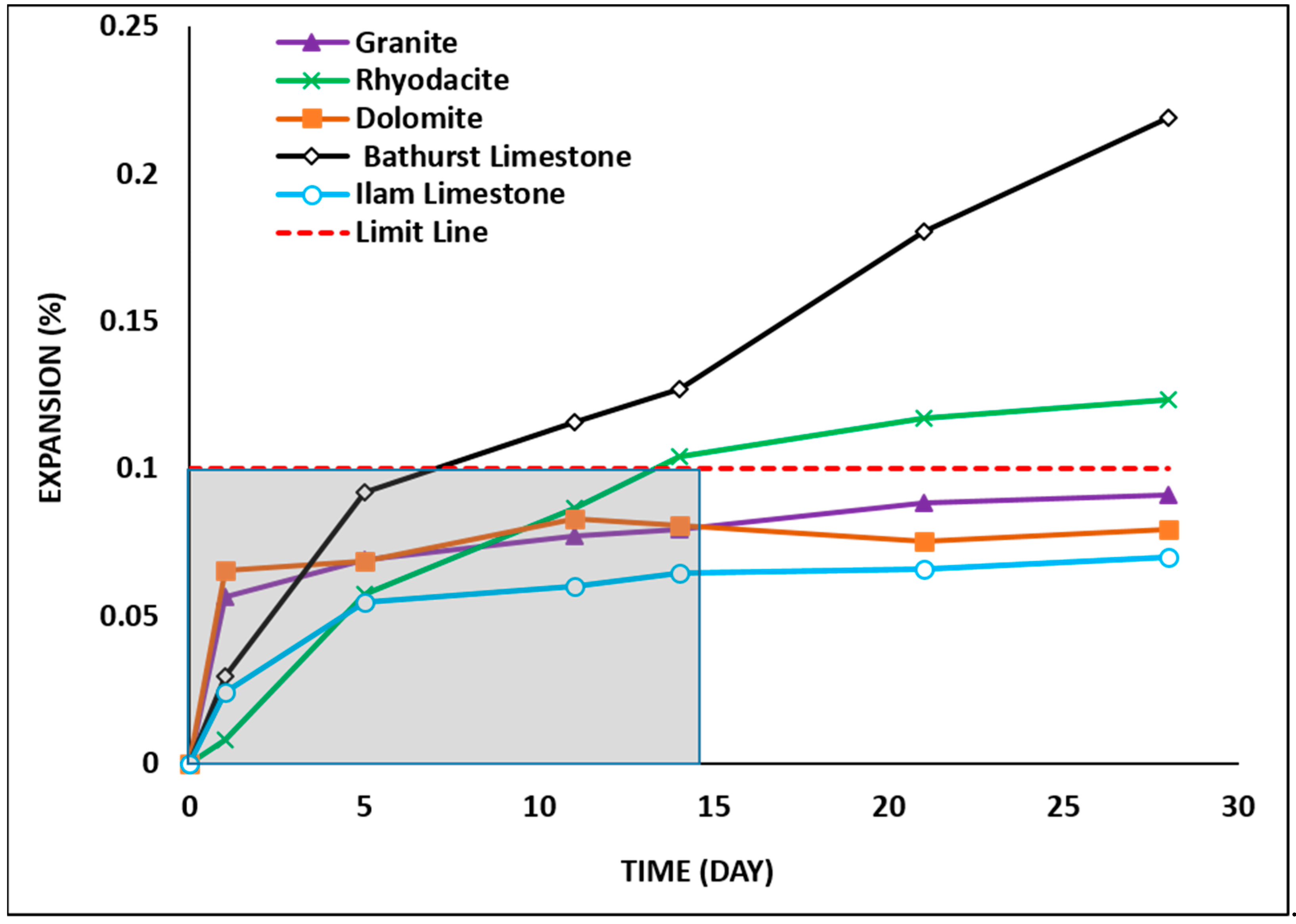
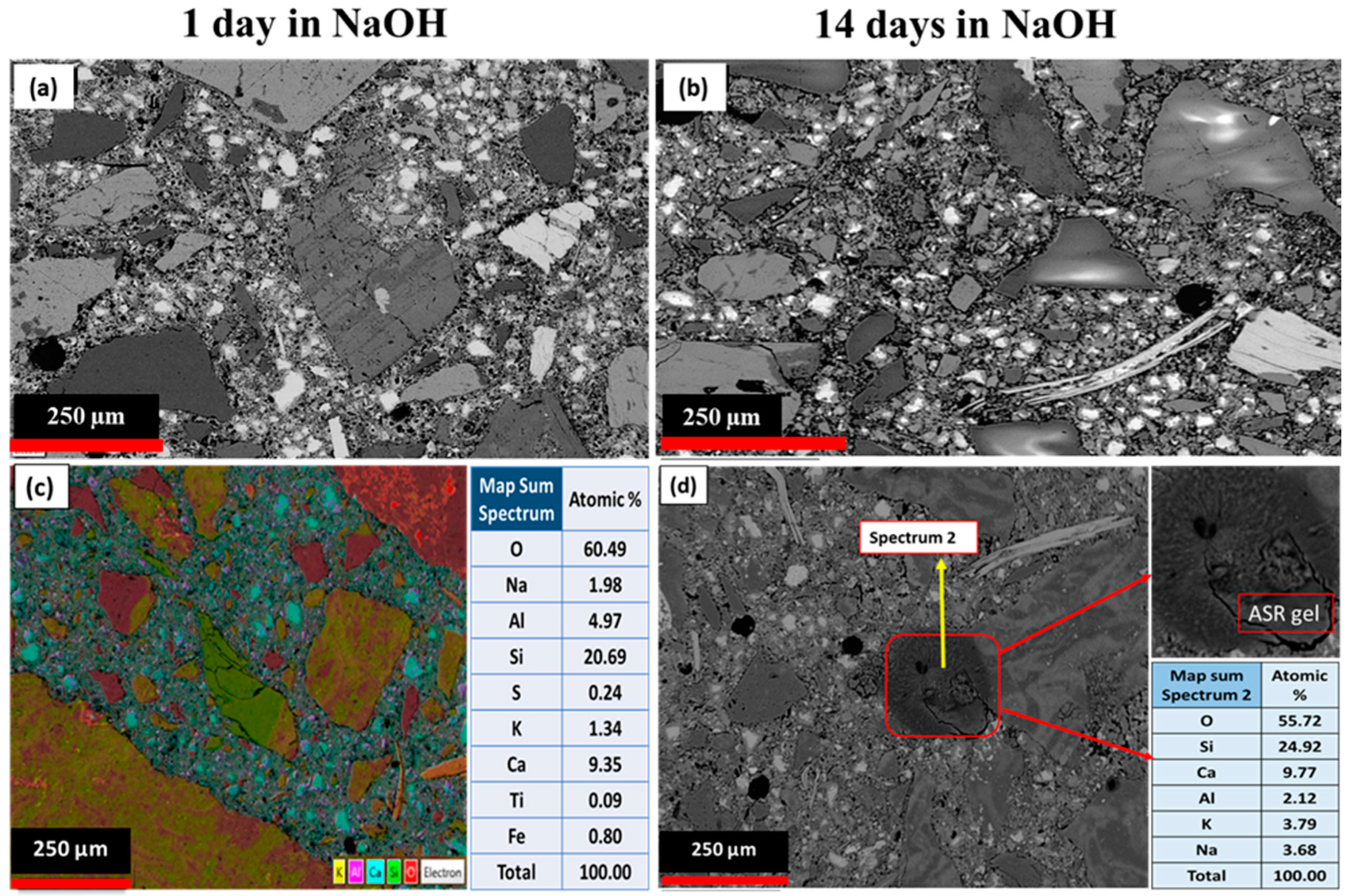
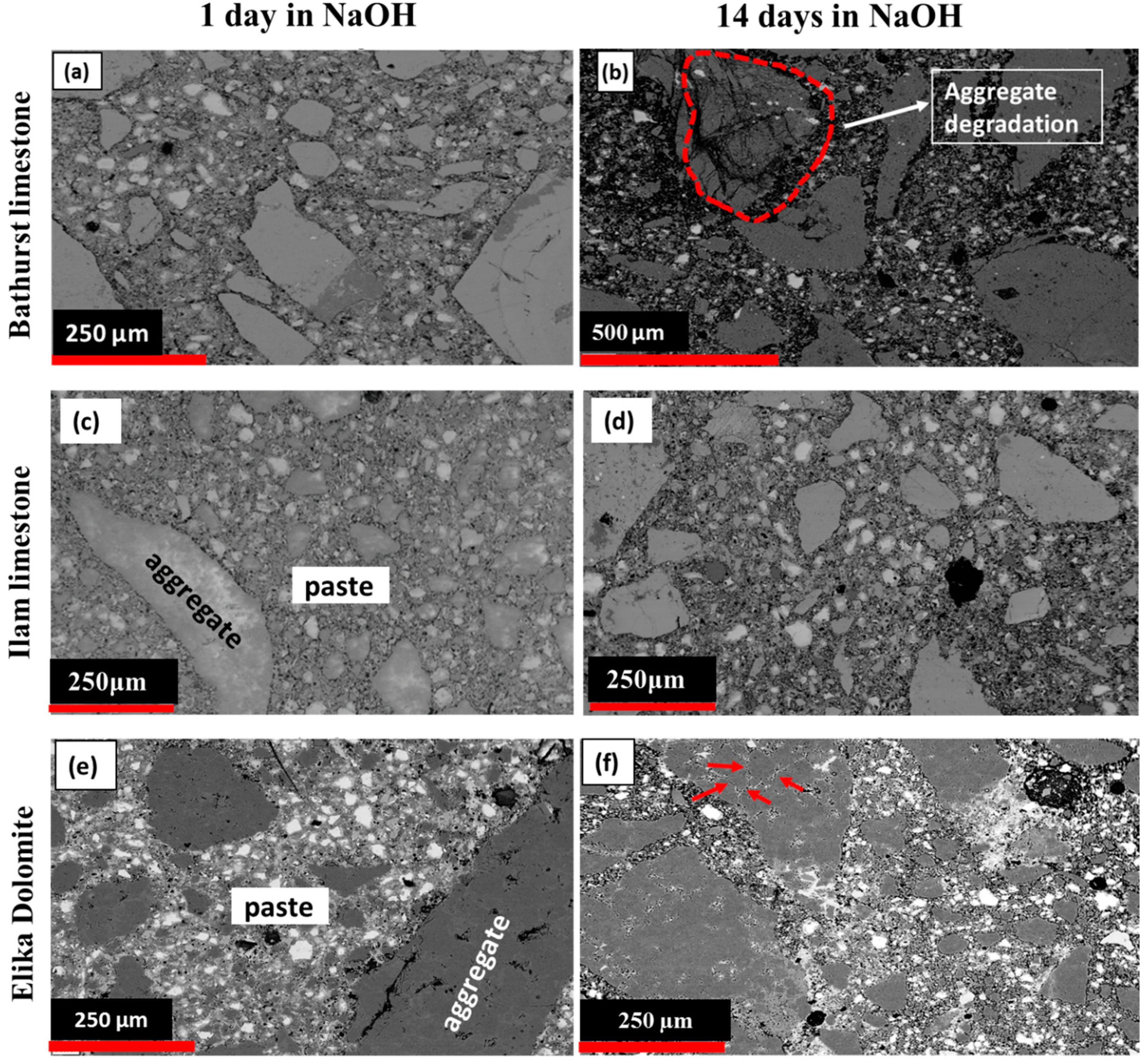

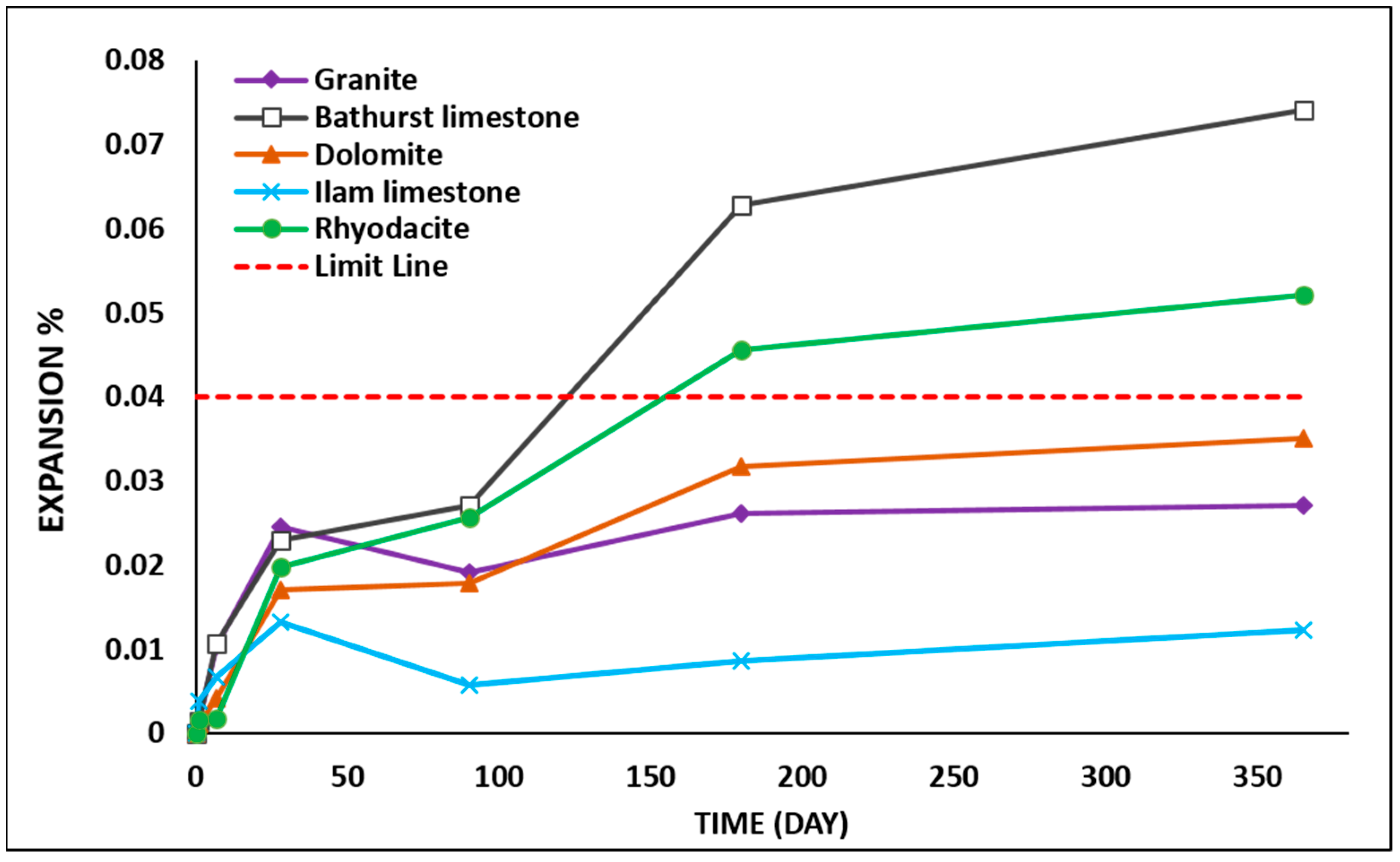
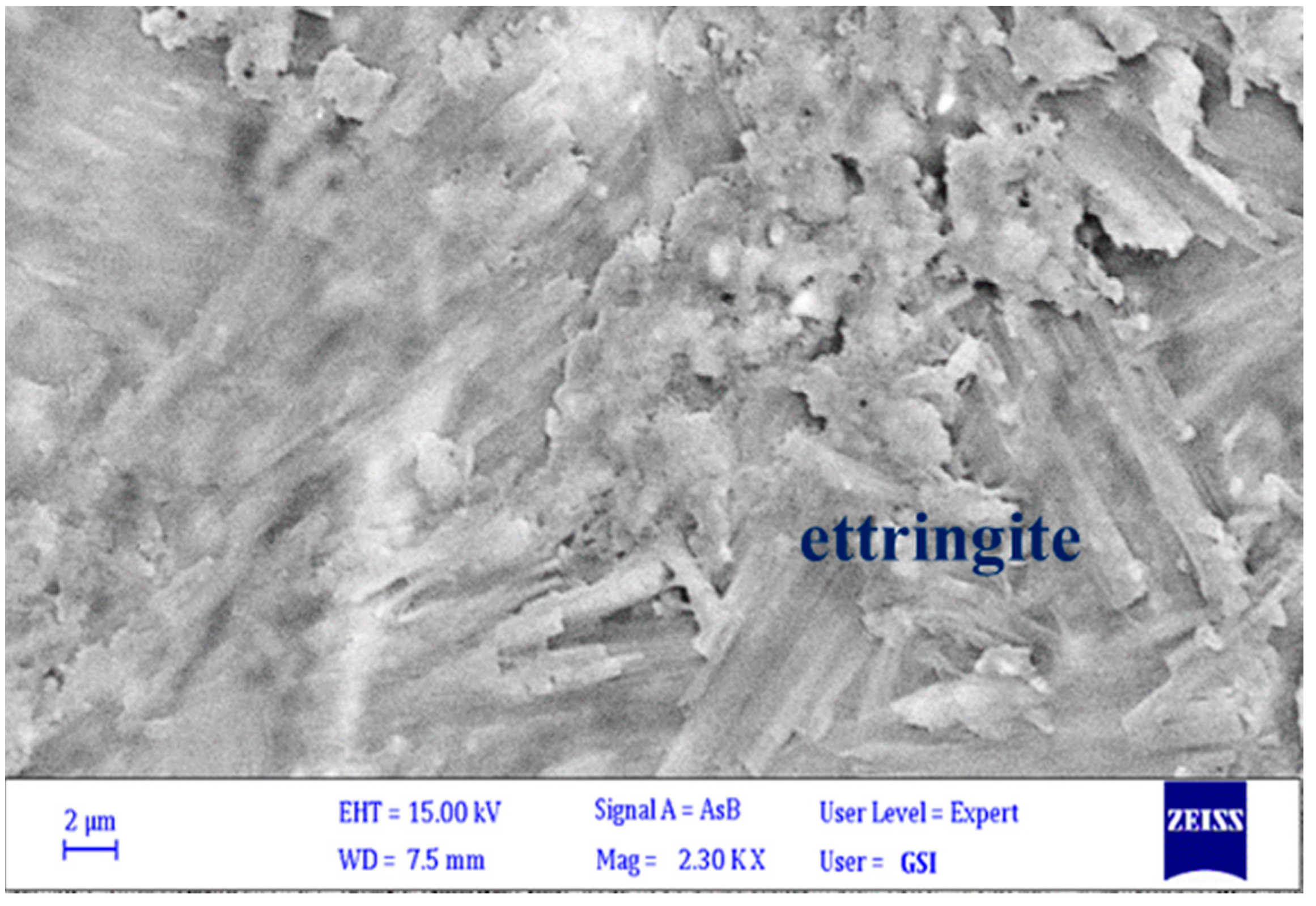

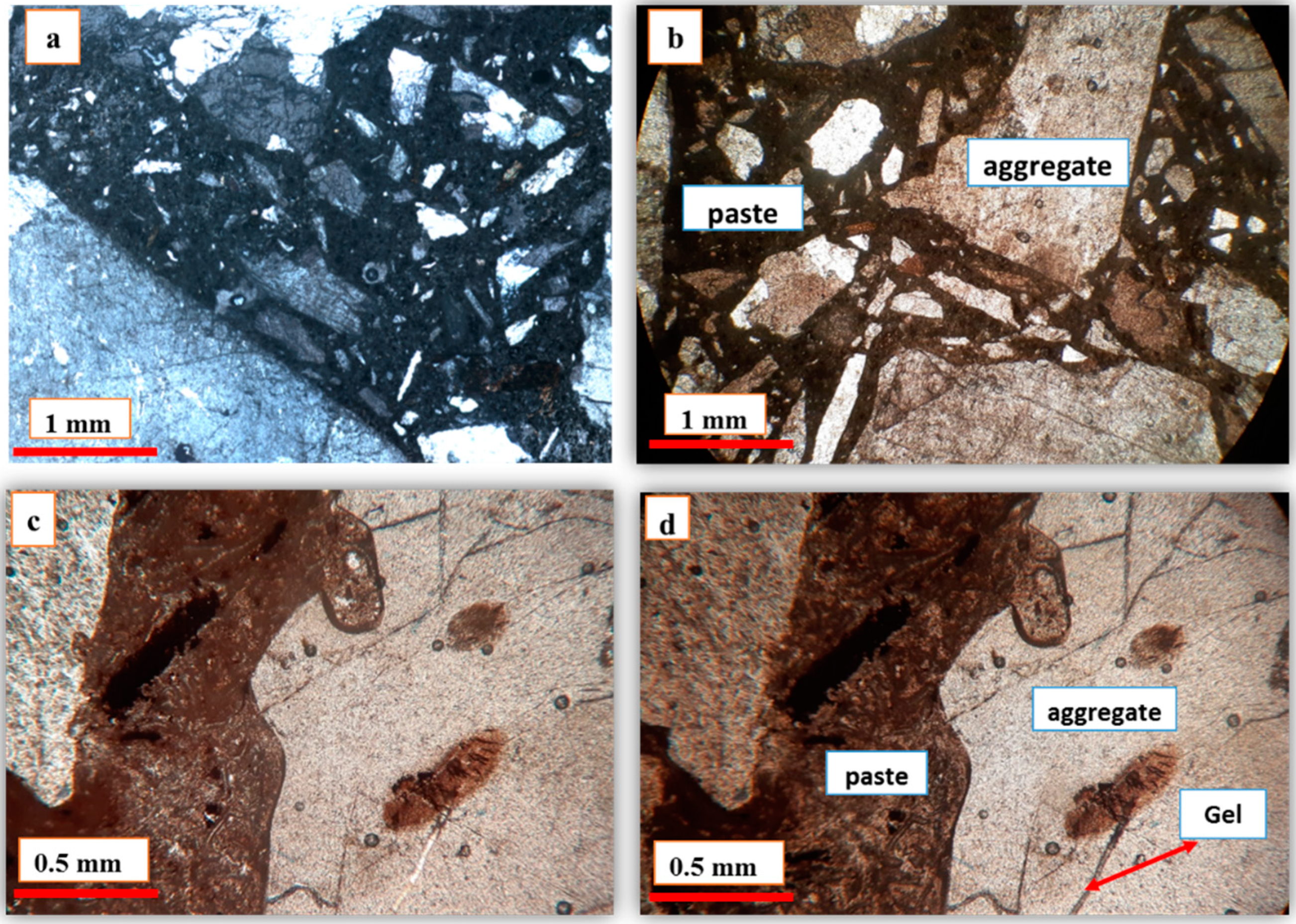

| Aggregate | Main Compositions | Trace Elements |
|---|---|---|
| Granite | Quartz, albite, orthoclase, biotite | Amphibole, calcite, pyrite |
| Rhyodacite | Quartz, albite, orthoclase, biotite | Amphibole, sanidine, sericite, calcite, hematite, kaolinite |
| Bathurst limestone | Calcite, quartz | |
| Ilam limestone | Calcite | Quartz |
| Dolomite | Dolomite, calcite | Quartz |
| Major Oxides | Plutonite | Volcanite | Sediment (Limestone) | |||
|---|---|---|---|---|---|---|
| Analyte | LLD | Granite | Rhyodacite | Bathurst | Ilam | Dolomite |
| SiO2 | 0.03 | 71.96 | 70.25 | 4.84 | 1.54 | 0.15 |
| Al2O3 | 0.01 | 13.82 | 14.74 | 1.25 | 0.48 | 0.03 |
| Fe2O3 | 0.01 | 2.65 | 2.76 | 0.80 | 0.31 | 0.59 |
| CaO | 0.01 | 1.72 | 1.98 | 51.35 | 54.23 | 31.19 |
| MgO | 0.01 | 0.43 | 0.67 | 0.64 | 0.36 | 20.80 |
| P2O5 | 0.01 | 0.09 | 0.13 | 0.10 | 0.05 | 0.04 |
| TiO2 | 0.01 | 0.22 | 0.29 | 0.06 | 0.00 | 0.00 |
| Na2O | 0.01 | 2.85 | 3.95 | 0.22 | 0.14 | 0.03 |
| K2O | 0.01 | 5.30 | 4.25 | 0.10 | 0.07 | 0.01 |
| MnO | 0.01 | 0.05 | 0.06 | 0.18 | 0.11 | 0.03 |
| CO2 | - | 0.91 | 0.92 | 40.46 | 42.71 | 47.13 |
| Analytical SUM | 100.00 | 100.00 | 100.00 | 100.00 | 100.00 | |
| Name | γd (KN/m3) | γsat (KN/m3) | ne (%) | Wa (%) | Vp (m/s) | Vs (m/s) | UCS (MPa) |
|---|---|---|---|---|---|---|---|
| Granite | 28.02 | 28.10 | 0.7 | 0.27 | 5126 | 2654 | 112.6 |
| Rhyodacite | 25.32 | 25.68 | 3.65 | 1.42 | 5067 | 2409 | 96 |
| Bathurst limestone | 26.22 | 26.56 | 2.22 | 1.45 | 4679 | 2423 | 48.78 |
| Ilam limestone | 26.66 | 26.68 | 1.97 | 0.84 | 4976 | 2657 | 58.56 |
| Dolomite | 27.31 | 27.59 | 1.04 | 0.78 | 4823 | 2575 | 61.92 |
Publisher’s Note: MDPI stays neutral with regard to jurisdictional claims in published maps and institutional affiliations. |
© 2022 by the authors. Licensee MDPI, Basel, Switzerland. This article is an open access article distributed under the terms and conditions of the Creative Commons Attribution (CC BY) license (https://creativecommons.org/licenses/by/4.0/).
Share and Cite
Kazemi, P.; Nikudel, M.R.; Khamehchiyan, M.; Giri, P.; Taheri, S.; Clark, S.M. Assessment of Alkali–Silica Reaction Potential in Aggregates from Iran and Australia Using Thin-Section Petrography and Expansion Testing. Materials 2022, 15, 4289. https://doi.org/10.3390/ma15124289
Kazemi P, Nikudel MR, Khamehchiyan M, Giri P, Taheri S, Clark SM. Assessment of Alkali–Silica Reaction Potential in Aggregates from Iran and Australia Using Thin-Section Petrography and Expansion Testing. Materials. 2022; 15(12):4289. https://doi.org/10.3390/ma15124289
Chicago/Turabian StyleKazemi, Pezhman, Mohammad Reza Nikudel, Mashalah Khamehchiyan, Paritosh Giri, Shima Taheri, and Simon Martin Clark. 2022. "Assessment of Alkali–Silica Reaction Potential in Aggregates from Iran and Australia Using Thin-Section Petrography and Expansion Testing" Materials 15, no. 12: 4289. https://doi.org/10.3390/ma15124289
APA StyleKazemi, P., Nikudel, M. R., Khamehchiyan, M., Giri, P., Taheri, S., & Clark, S. M. (2022). Assessment of Alkali–Silica Reaction Potential in Aggregates from Iran and Australia Using Thin-Section Petrography and Expansion Testing. Materials, 15(12), 4289. https://doi.org/10.3390/ma15124289









